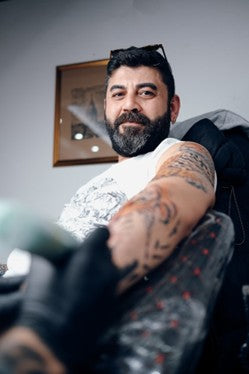
Adapting Tattoo Techniques for Every Client and Skin Type
Tattooing combines both artistry and technical skill, requiring a deep understanding of the skin—each client's skin is unique, with factors like tone, texture, and elasticity greatly influencing the process. These factors can affect how the needle penetrates the skin, how colors heal, and even how detailed the design can be. Adjusting techniques to suit each skin type ensures the best results. Additionally, selecting the right equipment, and inquiring what is the best wireless tattoo machine for the job, is essential to achieving precision and comfort. The right machine can reduce strain on the artist and provide a smoother experience for the client, further contributing to the success of the tattoo. This article explores how skin characteristics influence tattooing methods and provides tips on adapting techniques and choosing the best tools for optimal outcomes.

The Role of Skin Tone in Tattooing
Skin tone plays a crucial role in how tattoos appear and how artists select ink.
Ink Selection and Visibility
Lighter Skin Tones: Colors tend to appear vibrant and true to their original shade. Detailed work and subtle gradients often stand out more prominently.
Darker Skin Tones: While tattoos on darker skin are equally beautiful, certain colors, such as pastels or very light shades, may not show as vividly. Artists typically rely on bold, saturated colors like reds, blues, and blacks for higher visibility.
Adjusting Techniques
To ensure clarity on darker tones, artists often use thicker lines and bolder designs to prevent details from becoming indistinct. They also layer ink carefully, as overworking the skin can cause scarring or uneven healing.
Skin Texture: How Surface Variations Affect Tattooing
Skin texture varies due to factors like scarring, stretch marks, and natural irregularities. Each type requires specialized techniques to achieve smooth and even results.
Tattooing Over Scar Tissue
Scarred skin may be less elastic and more resistant to ink absorption. Artists need to apply ink slowly and deliberately, avoiding excessive pressure to prevent further damage.
Moreover, clients with scars should consult with their tattooist about realistic expectations, as results may differ from tattoos on unscarred skin.
Stretch Marks and Wrinkles
Stretch Marks: These areas often have thinner, more sensitive skin. Using smaller needles and lighter pressure can minimize discomfort and ensure consistent ink application.
Wrinkled Skin: Common in older clients, wrinkles require careful stretching during the tattooing process to provide a flat surface for precise designs.
Skin Elasticity: Adapting to Taut and Loose Skin
Elasticity—the skin's ability to stretch and return to its original shape—directly influences how tattoos are applied.
Youthful vs. Mature Skin
Youthful Skin: Typically more elastic, it allows for smoother needle application and better ink retention. Artists can work at a faster pace without compromising quality.
Mature Skin: Often less elastic, this type may require artists to work more slowly and stretch the skin carefully to achieve clean lines.
Tight vs. Loose Skin
Areas with naturally tighter skin, such as forearms and calves, are often easier to tattoo and heal faster. Loose areas, such as the abdomen or inner biceps, can be more challenging. Stretching techniques and consistent pressure are essential to maintain line integrity.
Skin Sensitivity and Pain Tolerance
Every client has a different pain threshold and skin sensitivity, which can affect their experience and the artist's approach.
Sensitive Skin Types
Some individuals have reactive skin prone to redness, swelling, or even allergic reactions. Testing a small area before starting the design can help assess sensitivity. Additionally, using hypoallergenic inks and ensuring a sterile environment minimizes risks.
Pain Management
Sensitive areas, such as ribs or ankles, may require shorter sessions to accommodate client comfort. Applying numbing creams or using advanced rotary machines that reduce vibration can make the process less painful.

Healing and Aftercare Considerations
Skin type also influences how tattoos heal, which impacts the final result.
Oily vs. Dry Skin
Oily skin presents its own unique challenges for tattooing. The excess oil can cause the ink to spread slightly, which may lead to blurred lines or uneven shading if not properly managed. To counter this, artists must frequently clean the area, ensuring that the surface is kept dry and free from excess oils. Aftercare is also essential for clients with oily skin; light ointments should be used to avoid further clogging pores or irritating the skin, which can lead to healing complications.
On the other hand, dry skin can be just as problematic but in a different way. Dry skin is more prone to cracking during the healing process, which can result in an uneven appearance or scabbing. Tattoo artists should advise clients with dry skin to properly moisturize the area, but it’s important not to over-saturate the tattooed region. Over-moisturizing can cause the skin to soften too much, potentially causing the ink to heal unevenly or blur. Clients should be guided to use a gentle, fragrance-free moisturizer that allows their skin to heal without disrupting the tattoo’s appearance.
Both skin types require careful attention to ensure the tattoo heals properly and retains its intended design. With the right care and attention to the skin's needs, tattoo artists can minimize complications, achieve crisp, clean lines, and help ensure the tattoo’s longevity and vibrancy.
Thick vs. Thin Skin
Thicker skin, found in areas like the palms, soles, and elbows, presents its own set of challenges for tattooing. Because of its dense, resilient texture, thicker skin requires deeper needle penetration to ensure the ink settles properly and evenly. Areas such as the palms and soles have a high concentration of collagen, which can make it harder for the ink to hold, so artists must adjust their technique accordingly, often applying more pressure or using a different needle type to achieve the desired effect. However, it’s important for artists to avoid over-penetrating, as this can lead to unnecessary trauma to the skin and cause ink to spread or heal improperly.
In contrast, thinner skin, commonly found in areas like the inner arms, wrists, and the face, is more delicate and prone to overworking, which can lead to skin irritation or excessive scabbing. Since thinner skin is less dense, it’s easier for ink to penetrate, but it also requires more precision. Artists need to use lighter pressure when working in these areas to avoid causing excessive trauma to the skin, which could result in faded or blurred tattoos. Careful control of needle depth and gentler techniques are essential in these cases to ensure the ink settles evenly without damaging the skin's delicate structure.
Each skin type requires its own specific approach, and by understanding the characteristics of thicker and thinner skin, tattoo artists can adapt their techniques to provide the best outcome while minimizing risk to the skin's health and the tattoo's clarity.
Ensuring Success Across All Skin Types
Consultation is Key: Before tattooing, discuss the client’s skin type, medical history, and expectations to tailor the process.
Invest in Quality Equipment: Adjustable needles and advanced machines can help artists work efficiently on various skin types.
Stay Educated: Attend workshops and seminars to learn about new techniques and materials designed for diverse skin characteristics.
Conclusion
Understanding and adapting to different skin types is a vital aspect of professional tattooing. By considering factors like tone, texture, elasticity, and sensitivity, tattoo artists can provide personalized care that ensures beautiful, lasting results. This client-focused approach not only enhances the quality of the artwork but also builds trust and satisfaction, setting artists apart in a competitive industry.
Whether you’re a seasoned professional or new to tattooing, mastering these techniques will empower you to create art that resonates with every unique canvas.



